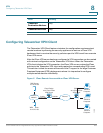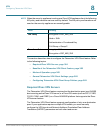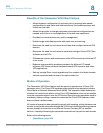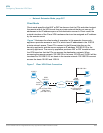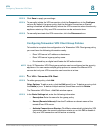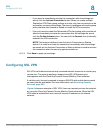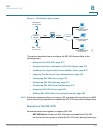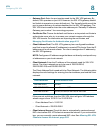
VPN
Configuring Teleworker VPN Client
Cisco ISA500 Series Integrated Security Appliances Administration Guide 370
8
• IKE Authentication Method: The VPN client must be properly authenticated
before it can access the remote network. Choose one of the following
authentication methods:
- Pre-shared Key: Choose this option if the IPsec VPN server uses a
simple, password-based key to authenticate and then enter the following
information:
Group Name: Enter the name of the IPsec Remote Access group policy
that is defined on the IPsec VPN server. The security appliance will use
this group policy to establish the VPN connection with the IPsec VPN
server. The IPsec VPN server pushes the security settings over the VPN
tunnel to the security appliance.
Password: Enter the pre-shared key specified in the selected group
policy to establish a VPN connection. The pre-shared key must be
entered exactly the same here and on the IPsec VPN server.
- Certificate: Choose this option if the IPsec VPN server uses the digital
certificate from a third party Certificate Authority (CA) to authenticate.
Select a CA certificate as your local certificate from the Local Certificate
drop-down list and select the CA certificate used on the remote IPsec
VPN server as the remote certificate from the Peer Certificate
drop-down list for authentication.
NOTE: You must have valid CA certificates imported on your security
appliance before choosing this option. Go to the Device Management >
Certificate Management page to import the CA certificates. See
Managing Certificates for Authentication, page 418.
• Mode: The operation mode determines whether the inside hosts relative to
the Cisco VPN hardware client are accessible from the corporate network
over the VPN tunnel. Specifying an operation mode is mandatory before
making a VPN connection because the Cisco VPN hardware client does not
have a default mode. For more information about the operation mode, see
Modes of Operation, page 365.
- Choose Client if you want the PCs and other devices on the security
appliance’s inside networks to form a private network with private IP
addresses. Network Address Translation (NAT) and Port Address
Translation (PAT) will be used. Devices outside the LAN will not be able to
ping devices on the LAN, or reach them directly.
- Choose NEM (Network Extension Mode) if you want the devices
connected to the inside interfaces to have IP addresses that are routable
and reachable by the destination network. The devices at both ends of




